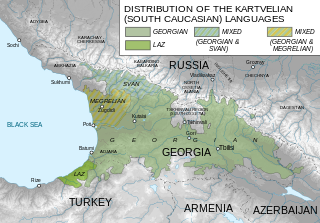Bahasa Laz
Bahasa Laz (ლაზური ნენა, lazuri nena; bahasa Georgia: ლაზური ენა, lazuri ena, or ჭანური ენა, ç̌anuri ena / ch’anuri ena) adalah sebuah bahasa Kartvelia yang dituturkan oleh suku Laz di pesisir tenggara Laut Hitam.[8] Bahasa tersebut diperkirakan dituturkan oleh sekitar 20.000[9] pengguna asli Laz di Turki, di serangkaian wilayah yang terbentang dari Melyat sampai perbatasan Georgia (secara resmi disebut Lazistan sampai 1925), dan sekitar 2.000 di Georgia.[9]
Referensi[sunting | sunting sumber]
- ^ "Laz alphabet, language and pronunciation". omniglot.com. Diakses tanggal Nov 15, 2020.
- ^ "Laz Language on Decline in Turkey - The Language Blog by K International". May 26, 2010. Diakses tanggal Nov 15, 2020.
- ^ Laz di Ethnologue (ed. ke-18, 2015)
- ^ Hammarström, Harald; Forkel, Robert; Haspelmath, Martin, ed. (2023). "Laz". Glottolog 4.8. Jena, Jerman: Max Planck Institute for the Science of Human History.
- ^ "UNESCO Interactive Atlas of the World's Languages in Danger" (dalam bahasa bahasa Inggris, Prancis, Spanyol, Rusia, and Tionghoa). UNESCO. 2011. Diarsipkan dari versi asli tanggal 29 April 2022. Diakses tanggal 26 Juni 2011.
- ^ "UNESCO Atlas of the World's Languages in Danger" (PDF) (dalam bahasa Inggris). UNESCO. 2010. Diarsipkan dari versi asli (PDF) tanggal 31 Mei 2022. Diakses tanggal 31 Mei 2022.
- ^ "Bahasa Laz". www.ethnologue.com (dalam bahasa Inggris). SIL Ethnologue.
- ^ E.J. Brill's First Encyclopaedia of Islam, 1913–1936, Volume 5, hlm. 21, di Google Books
- ^ a b "Laz". Ethnologue.
Daftar pustaka[sunting | sunting sumber]
- Grove, Timothy (2012). Materials for a Comprehensive History of the Caucasus, with an Emphasis on Greco-Roman Sources. A Star in the East: Materials for a Comprehensive History of the Caucasus, with an Emphasis on Greco-Roman sources (2012)
- Kojima, Gôichi (2003) Lazuri grameri Chiviyazıları, Kadıköy, İstanbul, ISBN 975-8663-55-0 (notes in English and Turkish)
- Nichols, Johanna (1998). The origin and dispersal of languages: Linguistic evidence. In N. G. Jablonski & L. C. Aiello (Eds.), The origin and diversification of language. San Francisco: California Academy of Sciences.
- Nichols, Johanna (2004). The origin of the Chechen and Ingush: A study in Alpine linguistic and ethnic geography. Anthropological Linguistics 46(2): 129-155.
- Tuite, Kevin. (1996). Highland Georgian paganism — archaism or innovation?: Review of Zurab K’ik’nadze. 1996. Kartuli mitologia, I. ǰvari da saq’mo. (Georgian mythology, I. The cross and his people [sic].). Annual of the Society for the Study of Caucasia 7: 79-91.
Pranala luar[sunting | sunting sumber]
- (dalam bahasa Turki) Lazkulturdernegi.org.tr
- (dalam bahasa Turki) Laz Cultur – Information about Lazs, Laz Language, Culture, Music
- (dalam bahasa Turki) Laz Cultur – Information about Lazs, Laz Language, Culture, Music
- (dalam bahasa Turki) Laz Cultur – Information about Lazs, Laz Language, Culture, Music and Laz Diaspora
- Lazuri Nena – The Language of the Laz by Silvia Kutscher.
- Laz-Turkish full dictionary in word format
- Samples of Laz Language in English, Dutch and Turkish, Arzu Barské - Erdogan Diarsipkan 2021-12-02 di Wayback Machine. on Yahoo! GeoCities
- Laz history and language, Lazlar, Yilmaz Erdogan on Yahoo! GeoCities
- Laz Georgian-Latin and Latin-Georgian converter



